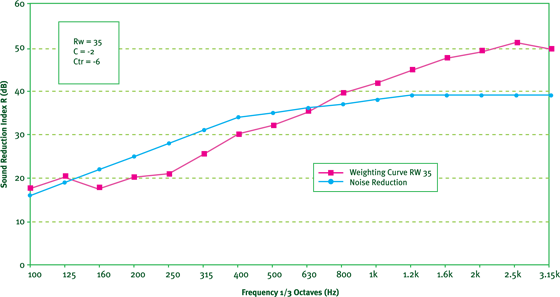Laboratory Acoustical Testing of
Wall System containing Expanded Polystyrene Foam
Test Objectives:
Measurement of airborne Sound Reduction Indices ( R ) of sample wall system in accordance with AS1191-2002 Acoustics – Method for Laboratory Measurement of Airborne Sound Transmission Loss of Building Elements.
Determination of Weighted Sound Reduction Indices ( R w ) and Spectrum Adaption Terms (C tr) in accordance with AS/NZS ISO 717.1.2004: Acoustics – Rating of sound insulation in buildings and of building elements – Airborne sound insulation.
Description of Test Specimens
| Side 1: | 6mm concrete render applied to 60mm thick expanded polystyrene foam. The polystyrene applied with sheet lengths vertical. Framing: 90mm timber studs at 450mm centres |
| Side 2: | 10mm Plasterboard applied with sheet lengths vertical. Joints no set, some visible gaps up to 8mm wide. Edges caulked with expanding polyurethane foam. |
Desciption of Test Facilities:
The tests were carried out in a purpose-designed transmission loss suite, comprising two adjoining reverberant rooms, designed in accordance with AS1191-1985.
Room construction:
solid concrete; independent construction for source and receiving rooms with separate foundations.
Room shape:
Rectangular parallelepiped for both rooms; aspect ratios 1.6:1.3:1 for both rooms
Room Volume:
Source room 100m3; receiving room 170m3 Average Absorption coefficient: less than 0.06 at all frequencies
Diffusers:
Receiving room diffuser area 30.7m2 compared with largest surface (floor/ceiling) of 40m2;ratio 0.75
Test Aperture:
3.16m x 3.16m (Nom). In this instance, craft wood jamb linings were fitted to the test aperture. These reduced the effective aperture area to 9.98m2.
Instrumentation
- Precision sound level meter, Rion NA-27 (S/N 00380650).
- Acoustical calibrator, Bruel & Kjaer type 4231 S/N 1897734.
- Sound source, custom made pink noise generator, 150W power amplifier and a stereo two-way loudspeaker system.
Test Procedures: Sound Source and Location
Broad band pink noise located in the rear trihedral corners of the source room.
Space and time average:
- Continuous moving path
- Repeated three times
- Path length approx 15m
- Averaging time 120 sec.
Equivalent Absorption:
Was determined by reverberation time measurement using the built-in software with the Rion NA-27 sound level meter. The sound source was used to excite the room. Two source locations were used each with tree microphone locations to comply with the Code.
Measurements Precision:
Each measurement was repeated three times. Repeatability was better than 1dB in every frequency band.
Test Results:
The test results are appended with a summary provided in Table 1 and complete 1/3 Octave data provided in Table 2.
Table 1: summary of Test Results
| Description | Acoustical Performance | |
| Side 1: | 6mm concrete render applied to 60mm thick expanded polystyrene foam. The polystyrene applied with sheet lengths vertical. | Rw 35, Ctr –6 |
| Framing: | 90mm timber studs at 450mm centres | |
| Side 2: | 10mm Plasterboard applied with sheet lengths vertical. Vertical joints not set, some visible gaps up to 8mm wide. Edges caulked with expanding polyurethane foam. | |
Table 2 – 1/3Octave Sound Reduction Indicies
| Frequency in 1/3rd Cctave Bands | ||||||||||||||||
|---|---|---|---|---|---|---|---|---|---|---|---|---|---|---|---|---|
| 100 | 125 | 160 | 200 | 250 | 315 | 400 | 500 | 630 | 800 | ik | 1.2k | 1.6k | 2k | 2.5k | 3.15k | |
| R (db) | 17.5 | 20.2 | 17.7 | 20.0 | 20.7 | 25.3 | 29.8 | 31.9 | 35.2 | 39.4 | 41.6 | 44.8 | 47.5 | 49.1 | 51.0 | 49.5 |
Weighted Sound Reduction Index (rw)
6mm Render, 60mm ESP on 90mm timber studs at 450mm centres, with 10mm plasterboard (Plasterboard joints no set, edges caulked with expandable polyurethane foam)



